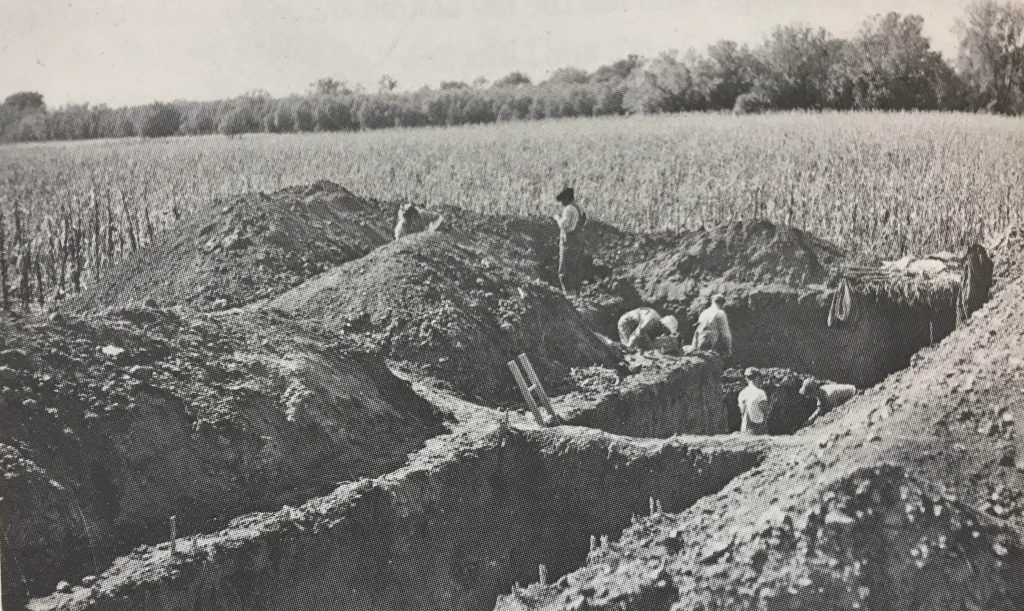The Cyclone of 1899 and Other Transformations of Earthly Things
Plymouth County

1899
More than one source reports that the cyclone (tornado) of 1899 turned an otherwise secular man toward reflection on otherworldly wisdom. The daytime storm was the second tornado to take out the bridge over the Big Sioux River, the first being in 1892. But the 1899 storm occurred in the daytime, sources say, and caught several men by surprise. While they sheltered beneath the bridge, they saw it lift skyward. Reports claim that one man especially expressed the feeling “that all earthly things pass away, sooner or later.” If he did say this, he would be among millions who have expressed profound feeling after witnessing severe weather.
Tornadoes are not the only severe events that so devastate a place that witnesses rethink their relationship to the Earth. Several important stories of Plymouth County history in which severe weather (in this case, drought) has faded to the background tell tales of loss but also of sometimes surprising resistance and resilience. Rodney Karr has written, for example, about the farmer rebels in Plymouth County, the so-called Holiday Movement that transpired from August 1932 to April 1933. Karr is not so much interested just to tell the story of the organization of Plymouth County farmers to fight together the plummeting prices for their agricultural products and also the threatened foreclosure on much of their land. He particularly explores who the rebellious farmers were. They were not, for example, outside agitators—”hoodlums from Sioux City or Communists from the Dakotas”– but were in fact farmers from the county though not all were land-owners. They were especially from the southeast corner of the county where a number of activists in their thirties were the sons of land-owners working alongside or across from their fathers to cultivate and maintain the land that they would one day inherit. When they picketed highways and halted foreclosures and even dragged a judge from a courtroom in LeMars for refusing to promise to support an Iowa mortgage moratorium bill, they were not content to let earthly things pass away. The leader of this last action was convicted and jailed for a year for his role in this threat to the judge’s life. Charles O. Larson, in his history of the county wrote, in a letter in 1976,“farm violence and business policy of the depression years left tensions which have not entirely disappeared.”
One history of profound loss concerns the transferal of county lands from Indian nations to new settlers. As some historians point out, the land was paid for. And yet, in the early 1860s rumors of the “Sioux” (Lakota/Dakota) coming down the Big Sioux valley en masse together with the removal of protective federal troops to the battles of the Civil War deterred settlement in the county–though the rumors never proved to be true. Early historians claim that the effect of these Indian scares only significantly diminished when President Lincoln agreed to the controversial execution at Mankato (MN) of Indians accused of violence. Also a reported factor in silencing fearful rumors was the formation of a Frontier Guard to replace the absent federal troops. These locals, though untrained, were said to have “routed” a group of Indians stealing horses.
The settlers’ stories of the Lakota/Dakota and “Winnebago” (Ho-chunk) who reentered the county to hunt are often ones of a people who have experienced a considerable loss of their future prospects. In 1893 Captain Betsworth recalled his life in his cabin in 1866 and the spring and autumn arrival of Ho-chunk on hunting expeditions, sometimes scores or even hundreds, he recalls. He says that he “generally turned none away” but after one especially unsuccessful hunt, he had insufficient food to share with the large party of “half-starved” Indians. Captain Betsworth’s story doesn’t tell us why it might have been a bad year for hunting. Was it a condition of the weather or overhunting, both or something else? The Captain’s story also doesn’t say—perhaps didn’t know– that the federal government first attempted to remove the Ho-chunk from Wisconsin to the Iowa Neutral Ground in 1832, and tried to force removal in 1841 and again in 1873-74. Most Ho-chunk either did not leave Wisconsin, buying land there, or returned to Wisconsin after removal to Iowa. But a few did remain west of the Mississippi River, moving from the Iowa Neutral Ground into Minnesota and South Dakota. Years before Captain Betsworth’s remembered encounter with the Ho-chunk, the federal government established reservation land in Nebraska for them. Though the Ho-chunk resided across the Missouri in 1866 when the Captain saw them and still resided across the Missouri River in Nebraska in 1893 when he remembered them and reside there into the present, the Captain’s memory recalls a group whose loss would seem to be complete. Not all that seems to pass away actually does.
This is certainly true of the extraordinary, 2017-designated National Historic Landmark in Plymouth County: Kimball Village. This 800-year-old “landmark,” an in tact human village, exists so well preserved, ironically, because its site beneath a current farmer’s field has been so thoroughly hidden. The 9000 artifacts that archaeologists have recovered at the site tell the story of a village with timber-framed houses, a protective outer wall, and a wealth of objects from all over North America. These 12th-century residents along the Big Sioux were successful traders. Like 21st-century residents of Plymouth County, they raised corn–and they hunted bison. Archaeologists speculate the settlement might have been an early one of the Mandan and Hidatsa people who moved further up the Missouri River where, centuries later, their descendants encountered Lewis and Clark exploring the far reaches of the continent for the new United States republic.
Visitors can see some of the 9000 artifacts at the Sioux City Public Museum.
